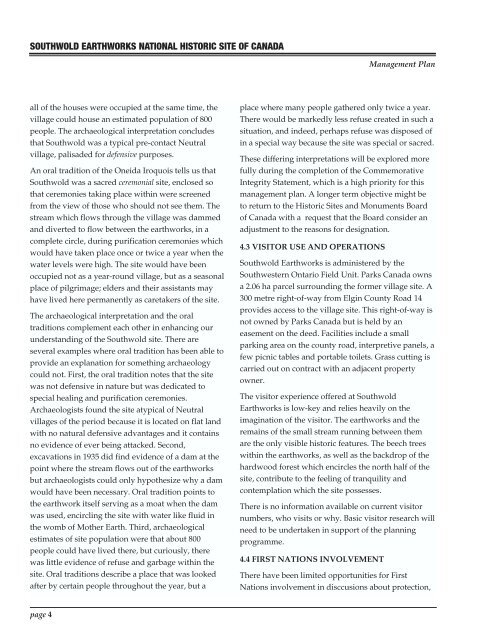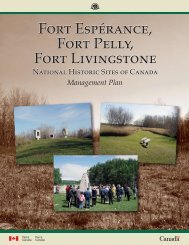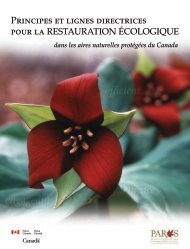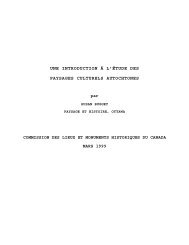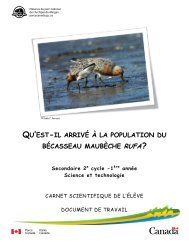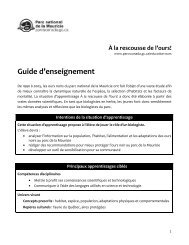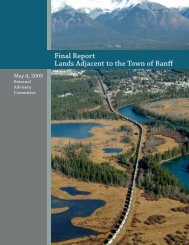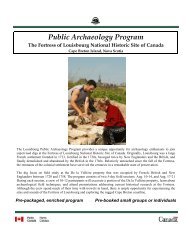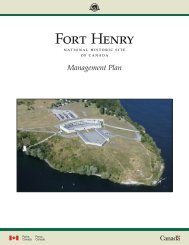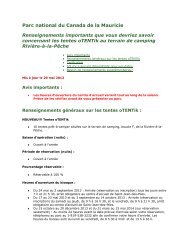Southwold Earthworks National Historic Site of Canada ...
Southwold Earthworks National Historic Site of Canada ...
Southwold Earthworks National Historic Site of Canada ...
Create successful ePaper yourself
Turn your PDF publications into a flip-book with our unique Google optimized e-Paper software.
SOUTHWOLD EARTHWORKS NATIONAL HISTORIC SITE OF CANADA<br />
Management Plan<br />
all <strong>of</strong> the houses were occupied at the same time, the<br />
village could house an estimated population <strong>of</strong> 800<br />
people. The archaeological interpretation concludes<br />
that <strong>Southwold</strong> was a typical pre-contact Neutral<br />
village, palisaded for defensive purposes.<br />
An oral tradition <strong>of</strong> the Oneida Iroquois tells us that<br />
<strong>Southwold</strong> was a sacred ceremonial site, enclosed so<br />
that ceremonies taking place within were screened<br />
from the view <strong>of</strong> those who should not see them. The<br />
stream which flows through the village was dammed<br />
and diverted to flow between the earthworks, in a<br />
complete circle, during purification ceremonies which<br />
would have taken place once or twice a year when the<br />
water levels were high. The site would have been<br />
occupied not as a year-round village, but as a seasonal<br />
place <strong>of</strong> pilgrimage; elders and their assistants may<br />
have lived here permanently as caretakers <strong>of</strong> the site.<br />
The archaeological interpretation and the oral<br />
traditions complement each other in enhancing our<br />
understanding <strong>of</strong> the <strong>Southwold</strong> site. There are<br />
several examples where oral tradition has been able to<br />
provide an explanation for something archaeology<br />
could not. First, the oral tradition notes that the site<br />
was not defensive in nature but was dedicated to<br />
special healing and purification ceremonies.<br />
Archaeologists found the site atypical <strong>of</strong> Neutral<br />
villages <strong>of</strong> the period because it is located on flat land<br />
with no natural defensive advantages and it contains<br />
no evidence <strong>of</strong> ever being attacked. Second,<br />
excavations in 1935 did find evidence <strong>of</strong> a dam at the<br />
point where the stream flows out <strong>of</strong> the earthworks<br />
but archaeologists could only hypothesize why a dam<br />
would have been necessary. Oral tradition points to<br />
the earthwork itself serving as a moat when the dam<br />
was used, encircling the site with water like fluid in<br />
the womb <strong>of</strong> Mother Earth. Third, archaeological<br />
estimates <strong>of</strong> site population were that about 800<br />
people could have lived there, but curiously, there<br />
was little evidence <strong>of</strong> refuse and garbage within the<br />
site. Oral traditions describe a place that was looked<br />
after by certain people throughout the year, but a<br />
place where many people gathered only twice a year.<br />
There would be markedly less refuse created in such a<br />
situation, and indeed, perhaps refuse was disposed <strong>of</strong><br />
in a special way because the site was special or sacred.<br />
These differing interpretations will be explored more<br />
fully during the completion <strong>of</strong> the Commemorative<br />
Integrity Statement, which is a high priority for this<br />
management plan. A longer term objective might be<br />
to return to the <strong>Historic</strong> <strong>Site</strong>s and Monuments Board<br />
<strong>of</strong> <strong>Canada</strong> with a request that the Board consider an<br />
adjustment to the reasons for designation.<br />
4.3 VISITOR USE AND OPERATIONS<br />
<strong>Southwold</strong> <strong>Earthworks</strong> is administered by the<br />
Southwestern Ontario Field Unit. Parks <strong>Canada</strong> owns<br />
a 2.06 ha parcel surrounding the former village site. A<br />
300 metre right-<strong>of</strong>-way from Elgin County Road 14<br />
provides access to the village site. This right-<strong>of</strong>-way is<br />
not owned by Parks <strong>Canada</strong> but is held by an<br />
easement on the deed. Facilities include a small<br />
parking area on the county road, interpretive panels, a<br />
few picnic tables and portable toilets. Grass cutting is<br />
carried out on contract with an adjacent property<br />
owner.<br />
The visitor experience <strong>of</strong>fered at <strong>Southwold</strong><br />
<strong>Earthworks</strong> is low-key and relies heavily on the<br />
imagination <strong>of</strong> the visitor. The earthworks and the<br />
remains <strong>of</strong> the small stream running between them<br />
are the only visible historic features. The beech trees<br />
within the earthworks, as well as the backdrop <strong>of</strong> the<br />
hardwood forest which encircles the north half <strong>of</strong> the<br />
site, contribute to the feeling <strong>of</strong> tranquility and<br />
contemplation which the site possesses.<br />
There is no information available on current visitor<br />
numbers, who visits or why. Basic visitor research will<br />
need to be undertaken in support <strong>of</strong> the planning<br />
programme.<br />
4.4 FIRST NATIONS INVOLVEMENT<br />
There have been limited opportunities for First<br />
Nations involvement in disccusions about protection,<br />
page 4


